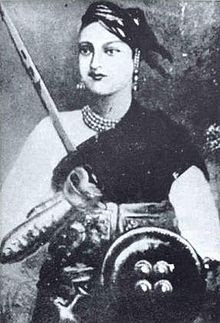Rani Lakshmibai of Jhansi Jayanthi
 Rani Lakshmi Bai, the fiery Queen of Jhansi, also known as the Rani of Jhansi, one of the great  nationalist  heroine  of   the first war of India freedom, a symbol of resistance to  the British rule in India was born on 19th November 1835 at Kashi (Presently  known as Varanasi). Her father Moropanth was a Brahmin and her mother Bhagirathibai was a cultured, intelligent and God fearing lady. Mannikarnika (Manu) was the name of Rani Lakshmi  Bai in her childhood. Manu  lost her  mother at the age of four. The Complete responsibility of the young girl fell on the father. She completed her education and also learned horse riding, Sword fighting and shooting on a target with a gun.
Rani Lakshmi Bai, the fiery Queen of Jhansi, also known as the Rani of Jhansi, one of the great  nationalist  heroine  of   the first war of India freedom, a symbol of resistance to  the British rule in India was born on 19th November 1835 at Kashi (Presently  known as Varanasi). Her father Moropanth was a Brahmin and her mother Bhagirathibai was a cultured, intelligent and God fearing lady. Mannikarnika (Manu) was the name of Rani Lakshmi  Bai in her childhood. Manu  lost her  mother at the age of four. The Complete responsibility of the young girl fell on the father. She completed her education and also learned horse riding, Sword fighting and shooting on a target with a gun.
She was married to Raja Gangadhar Rao, the Maharaja of Jhansi in 1842, and became the Rani of Jhansi. After the marriage She was given the name Lakshmi Bai. The Marriage ceremony was perform in Ganesh Mandir, the temple of Lord Ganesha situated in the city of Jhansi. Rani Lakshmi Bai gave birth to a son in 1851, but unfortunately this child died when he was about four months old. After this tragedy, Damodar Rao was adopted as son. Later on Maharaja Gangadhar Rao also died on 21st November 1853. After the death of Maharaja Gangadhar Rao, Rani Lakshmi Bai was left alone. At this time she was eighteen years old. Rani Lakshmi Bai did not lost her courage, She always remembered her responsibility.
At that time Lord Dalhousie was the Governor -General of India. Though little Damodar Rao, adopted son of late Maharaja Gangadhar Rao and Rani Lakshmi Bai was Maharaja’s heir and successor as per the Hindu tradition, but the British rulers rejected Rani’s claim that Damodar Rao was their legal heir. Loard Dalhousie decided to annexe the state of Jhansi as Maharaja Gangadhar Rao had left no legal heir. This misfortune of Jhansi was used by the Britishers to expand there Empire.
In March 1854 the British ruler announced 60,000 ( Sixty Thousand) annual pension for Rani and also ordered to leave the Jhansi fort. Jhansi was in humiliating condition but it was like a silent volcano before eruption.
Rani Jhansi was determined not to give up Jhansi. She was a symbol of patriotism and self respect. Britishers were making every effort to destroy the freedom of country whereas Rani was determined to get rid of Britishers.
Rani Lakshmi Bai strengthened the defense of Jhansi and she assembled a volunteer army of rebellions. Women were also given Military training. Rani was accompanied by her brave warriors, some of them were Gulam Gaus Khan, Dost Khan, Khuda Baksh, Lala Bhau Bakshi, Moti Bai, Sunder-Mundar, Kashi Bai, Deewan Raghunath singh and Deewan Jawahar Singh. Along with all these warriors the local population of Jhansi irrespective of their religion or caste were always determined to fight and give their lives with pleasure for the cause of Independent and their beloved Rani.
The Britishers attacked Jhansi in March 1858. Rani Jhansi with her faithful warriors decided not to surrender. The fighting continued for about two weeks. Shelling on Jhansi was very fierce. In the Jhansi army women were also carrying ammunition and were supplying food to the soldiers. Rani Lakshmi Bai was very active. She herself was inspecting the defense of the city. However, after this great war, Jhansi fell to the British forces.
On that black day, the British army entered the Jhansi City. Rani Lakshmi Bai, still full of courage and deathless patriotism dressed as a man, took up arms, her son Damodar Rao was strapped tightly to her back. She was holding the reins of her horse in her mouth. In the fierce fighting she was using the sword with both her hands. When the situation was not in control, Rani of Jhansi with some of her warriors departed from Jhansi.
Rani Lakshmi Bai reched Kalpi. Many other rebellions force joined her. Tatia Tope from Kalpi was also one of them, from Kalpi Rani departed to the Gwalior. Again a fierce battle took place. Rani Jhansi fought with deathless patriotism and martyrdom. However on the second day of fighting, the great heroine of the first struggle for India freedom, at the age of 23 years, lost her life. That unfortunate day was 18th June of 1858
Welcome to Haindava Keralam! Register for Free or Login as a privileged HK member to enjoy auto-approval of your comments and to receive periodic updates.
Latest Articles from Bharath Focus
- Narendra Modi: The Architect of India’s Momentous Transformation
- Republic Day Tableaux & Regional Pride
- Tarun Vijay meets Governor Arif Khan on Adi Sankara birthplace
- SC-ST പോസ്റ്റ് മെട്രിക് സ്കോളർഷിപ്പിൽ 5 ഇരട്ടി വർദ്ധനവ്
- Treading the Middle-Path on Temple Management
- Taming the dragon-Part-3
- Taming the dragon- Part 2
- India- China trade wars on the cards? Well researched blog on Indian govt.’s proposed plan to tax 371 Chinese goods
- Before removing the idols, I should be removed; Two Kerala faces we should never forget
- The Unseen Unheard Victims of Article 35(A)

